Selective Removal of Chlorpyrifos from Contaminated Water Using Young Walnut-Derived Carbon Material as a Sustainable Adsorbent
Abstract
1. Introduction
2. Materials and Methods
2.1. Materials Synthesis and Characterization
2.2. Adsorption Experiments
2.3. Regeneration of Adsorbent
2.4. Adsorption of CHP and CPO from Binary Mixtures
2.5. Toxicity Evaluation
3. Results
3.1. Physicochemical Properties of the Synthesized Adsorbent
3.2. Adsorption Kinetics
3.3. Adsorption Isotherms
3.4. Thermodynamic Analysis
3.5. Selective Adsorption of CHP and CPO from Binary Mixtures
3.6. Dynamic Conditions, Regeneration, and Reusability of Adsorbent
3.7. Toxicity Assessment
4. Conclusions
Author Contributions
Funding
Data Availability Statement
Conflicts of Interest
References
- Mali, H.; Shah, C.; Raghunandan, B.H.; Prajapati, A.S.; Patel, D.H.; Trivedi, U.; Subramanian, R.B. Organophosphate pesticides an emerging environmental contaminant: Pollution, toxicity, bioremediation progress, and remaining challenges. J. Environ. Sci. 2023, 127, 234–250. [Google Scholar] [CrossRef]
- Sidhu, G.K.; Singh, S.; Kumar, V.; Dhanjal, D.S.; Datta, S.; Singh, J. Toxicity, monitoring and biodegradation of organophosphate pesticides: A review. Crit. Rev. Environ. Sci. Technol. 2019, 49, 1135–1187. [Google Scholar] [CrossRef]
- Wołejko, E.; Łozowicka, B.; Jabłońska-Trypuć, A.; Pietruszyńska, M.; Wydro, U. Chlorpyrifos occurrence and toxicological risk assessment: A review. Int. J. Environ. Res. Public Health 2022, 19, 12209. [Google Scholar] [CrossRef] [PubMed]
- Foong, S.Y.; Ma, N.L.; Lam, S.S.; Peng, W.; Low, F.; Lee, B.H.K.; Alstrup, A.K.O.; Sonne, C. A recent global review of hazardous chlorpyrifos pesticide in fruit and vegetables: Prevalence, remediation and actions needed. J. Hazard. Mater. 2020, 400, 123006. [Google Scholar] [CrossRef]
- Solomon, K.R.; Williams, W.M.; Mackay, D.; Purdy, J.; Giddings, J.M.; Giesy, J.P. Properties and uses of chlorpyrifos in the United States. In Ecological Risk Assessment for Chlorpyrifos in Terrestrial and Aquatic Systems in the United States; Springer: Cham, Switzerland, 2014; pp. 13–34. [Google Scholar] [CrossRef]
- John, E.M.; Shaike, J.M. Chlorpyrifos: Pollution and remediation. Environ. Chem. Lett. 2015, 13, 269–291. [Google Scholar] [CrossRef]
- Bhende, R.S.; Jhariya, U.; Srivastava, S.; Bombaywala, S.; Das, S.; Dafale, N.A. Environmental distribution, metabolic fate, and degradation mechanism of chlorpyrifos: Recent and future perspectives. Appl. Biochem. Biotechnol. 2022, 194, 2301–2335. [Google Scholar] [CrossRef]
- Wu, J.; Laird, D.A. Abiotic transformation of chlorpyrifos to chlorpyrifos oxon in chlorinated water. Environ. Toxicol. Chem. 2003, 22, 261–264. [Google Scholar] [CrossRef]
- Jameson, R.R.; Seidler, F.J.; Slotkin, T.A. Nonenzymatic functions of acetylcholinesterase splice variants in the developmental neurotoxicity of organophosphates: Chlorpyrifos, chlorpyrifos oxon, and diazinon. Environ. Health Perspect. 2007, 115, 65–70. [Google Scholar] [CrossRef]
- NPIC. Chlorpyrifos Technical Fact Sheet. Available online: https://npic.orst.edu/factsheets/archive/chlorptech.html (accessed on 19 August 2025).
- Saunders, M.; Magnanti, B.L.; Correia Carreira, S.; Yang, A.; Alamo-Hernández, U.; Riojas-Rodriguez, H.; Calamandrei, G.; Koppe, J.G.; Krayer von Krauss, M.; Keune, H. Chlorpyrifos and neurodevelopmental effects: A literature review and expert elicitation on research and policy. Environ. Health 2012, 11, S5. [Google Scholar] [CrossRef] [PubMed]
- Nandi, N.K.; Vyas, A.; Akhtar, M.J.; Kumar, B. The growing concern of chlorpyrifos exposures on human and environmental health. Pestic. Biochem. Physiol. 2022, 185, 105138. [Google Scholar] [CrossRef]
- Agency for Toxic Substances and Disease Registry (US). Toxicological Profile for Chlorpyrifos; National Library of Medicine, Ed.; Agency for Toxic Substances and Disease Registry (US): Atlanta, GA, USA, 1997; Volume 2.
- Badawy, M.I.; Ghaly, M.Y.; Gad-Allah, T.A. Advanced oxidation processes for the removal of organophosphorus pesticides from wastewater. Desalination 2006, 194, 166–175. [Google Scholar] [CrossRef]
- Sud, D.; Kaur, P. Heterogeneous photocatalytic degradation of selected organophosphate pesticides: A review. Crit. Rev. Environ. Sci. Technol. 2012, 42, 2365–2407. [Google Scholar] [CrossRef]
- Pehkonen, S.O.; Zhang, Q. The degradation of organophosphorus pesticides in natural waters: A critical review. Crit. Rev. Environ. Sci. Technol. 2002, 32, 17–72. [Google Scholar] [CrossRef]
- Satyam, S.; Patra, S. Innovations and challenges in adsorption-based wastewater remediation: A comprehensive review. Heliyon 2024, 10, e29573. [Google Scholar] [CrossRef]
- Akhtar, M.S.; Ali, S.; Zaman, W. Innovative adsorbents for pollutant removal: Exploring the latest research and applications. Molecules 2024, 29, 4317. [Google Scholar] [CrossRef]
- Badran, A.M.; Utra, U.; Yussof, N.S.; Bashir, M.J.K. Advancements in adsorption techniques for sustainable water purification: A focus on lead removal. Separations 2023, 10, 565. [Google Scholar] [CrossRef]
- Akhtar, M.; Sarfraz, M.; Ahmad, M.; Raza, N.; Zhang, L. Use of low-cost adsorbent for waste water treatment: Recent progress, new trend and future perspectives. Desalination Water Treat. 2025, 321, 100914. [Google Scholar] [CrossRef]
- Rashed, M.N. Adsorption technique for the removal of organic pollutants from water and wastewater. In Organic Pollutants—Monitoring, Risk and Treatment; IntechOpen: London, UK, 2013. [Google Scholar]
- Chaturvedi, P.; Giri, B.S.; Shukla, P.; Gupta, P. Recent advancement in remediation of synthetic organic antibiotics from environmental matrices: Challenges and perspective. Bioresour. Technol. 2021, 319, 124161. [Google Scholar] [CrossRef]
- Tan, X.-F.; Zhu, S.-S.; Wang, R.-P.; Chen, Y.-D.; Show, P.-L.; Zhang, F.-F.; Ho, S.-H. Role of biochar surface characteristics in the adsorption of aromatic compounds: Pore structure and functional groups. Chin. Chem. Lett. 2021, 32, 2939–2946. [Google Scholar] [CrossRef]
- Tabassum, N.; Rafique, U.; Balkhair, K.S.; Ashraf, M.A. Chemodynamics of methyl parathion and ethyl parathion: Adsorption models for sustainable agriculture. BioMed Res. Int. 2014, 2014, 831989. [Google Scholar] [CrossRef]
- Barbhuiya, S.; Das, B.B.; Kanavaris, F. Biochar-concrete: A comprehensive review of properties, production and sustainability. Case Stud. Constr. Mater. 2024, 20, e02859. [Google Scholar] [CrossRef]
- Kumar Mishra, R.; Jaya Prasanna Kumar, D.; Narula, A.; Minnat Chistie, S.; Ullhas Naik, S. Production and beneficial impact of biochar for environmental application: A review on types of feedstocks, chemical compositions, operating parameters, techno-economic study, and life cycle assessment. Fuel 2023, 343, 127968. [Google Scholar] [CrossRef]
- Liu, Y.; Wang, Y.; Zou, L.; Bai, Y.; Xiu, H. Research on the optimum carbonization process of walnut shell based on dynamic analysis. RSC Adv. 2023, 13, 13412–13422. [Google Scholar] [CrossRef]
- Queirós, C.S.G.P.; Cardoso, S.; Lourenço, A.; Ferreira, J.; Miranda, I.; Lourenço, M.J.V.; Pereira, H. Characterization of walnut, almond, and pine nut shells regarding chemical composition and extract composition. Biomass Convers. Biorefinery 2020, 10, 175–188. [Google Scholar] [CrossRef]
- Jahanban-Esfahlan, A.; Ostadrahimi, A.; Tabibiazar, M.; Amarowicz, R. A comprehensive review on the chemical constituents and functional uses of walnut (Juglans spp.) husk. Int. J. Mol. Sci. 2019, 20, 3920. [Google Scholar] [CrossRef]
- Manterola-Barroso, C.; Godoy Sanchez, K.; Scheuermann, E.; Padilla-Contreras, D.; Morina, F.; Meriño-Gergichevich, C. Antioxidant and Physico-Structural Insights of Walnut (Juglans regia) and Hazelnut (Corylus avellana L.) Shells: Implications for Southern Chile By-Product Valorization. Resources 2025, 14, 82. [Google Scholar] [CrossRef]
- Foo, K.Y.; Hameed, B.H. Coconut husk derived activated carbon via microwave induced activation: Effects of activation agents, preparation parameters and adsorption performance. Chem. Eng. J. 2012, 184, 57–65. [Google Scholar] [CrossRef]
- Demirbas, A. Heavy metal adsorption onto agro-based waste materials: A review. J. Hazard. Mater. 2008, 157, 220–229. [Google Scholar] [CrossRef]
- Available online: https://sdgresources.relx.com (accessed on 19 August 2025).
- Zlatković, M.; Kurtić, R.; Pašti, I.A.; Tasić, T.; Milanković, V.; Potkonjak, N.; Unterweger, C.; Lazarević-Pašti, T. Application of Carbon Materials Derived from Nocino Walnut Liqueur Pomace Residue for Chlorpyrifos Removal from Water. Materials 2025, 18, 3072. [Google Scholar] [CrossRef] [PubMed]
- Osterrieth, J.W.M.; Rampersad, J.; Madden, D.; Rampal, N.; Skoric, L.; Connolly, B.; Allendorf, M.D.; Stavila, V.; Snider, J.L.; Ameloot, R. How reproducible are surface areas calculated from the BET equation? Adv. Mater. 2022, 34, 2201502. [Google Scholar] [CrossRef] [PubMed]
- Lazarević-Pašti, T.D.; Bondžić, A.M.; Pašti, I.A.; Vasić, V.M. Indirect electrochemical oxidation of organophosphorous pesticides for efficient detection via acetylcholinesterase test. Pestic. Biochem. Physiol. 2012, 104, 236–242. [Google Scholar] [CrossRef]
- Ellman, G.L.; Courtney, K.D.; Andres, V.; Featherstone, R.M. A new and rapid colorimetric determination of acetylcholinesterase activity. Biochem. Pharmacol. 1961, 7, 88–95. [Google Scholar] [CrossRef] [PubMed]
- Milanković, V.; Tasić, T.; Brković, S.; Potkonjak, N.; Unterweger, C.; Pašti, I.; Lazarević-Pašti, T. Sustainable carbon materials from biowaste for the removal of organophosphorus pesticides, dyes, and antibiotics. J. Environ. Manag. 2025, 376, 124463. [Google Scholar] [CrossRef] [PubMed]
- Simões dos Reis, G.; Mayandi Subramaniyam, C.; Cárdenas, A.D.; Larsson, S.H.; Thyrel, M.; Lassi, U.; García-Alvarado, F. Facile Synthesis of Sustainable Activated Biochars with Different Pore Structures as Efficient Additive-Carbon-Free Anodes for Lithium- and Sodium-Ion Batteries. ACS Omega 2022, 7, 42570–42581. [Google Scholar] [CrossRef]
- Zhu, M.; Lan, J.; Zhang, X.; Sui, G.; Yang, X. Porous carbon derived from Ailanthus altissima with unique honeycomb-like microstructure for high-performance supercapacitors. New J. Chem. 2017, 41, 4281–4285. [Google Scholar] [CrossRef]
- Tulun, Ş.; Akgül, G.; Alver, A.; Celebi, H. Adaptive neuro-fuzzy interference system modelling for chlorpyrifos removal with walnut shell biochar. Arab. J. Chem. 2021, 14, 103443. [Google Scholar] [CrossRef]
- Pandey, P.; Kenchannavar, P.; Surenjan, A. Exploring the potential of cashew nut shell biochar for chlorpyrifos pesticide removal. Chem. Eng. Process.-Process Intensif. 2025, 213, 110307. [Google Scholar] [CrossRef]
- Asghar, A.; Mabarak, S.; Ashraf, B.; Rizwan, M.; Massey, S.; Asghar, B.H.; Shahid, B.; Rasheed, T. A sustainable approach for the removal of chlorpyrifos pesticide from aqueous phase using novel nano magnetized biochar. Inorg. Chem. Commun. 2024, 159, 111790. [Google Scholar] [CrossRef]
- Zgolli, A.; Fizer, M.; Mariychuk, R.; Dhaouadi, H. Insights into the adsorption mechanism of chlorpyrifos on activated carbon derived from prickly pear seeds waste: An experimental and DFT modeling study. Environ. Res. 2024, 263, 120221. [Google Scholar] [CrossRef]
- Jacob, M.M.; Ponnuchamy, M.; Kapoor, A.; Sivaraman, P. Bagasse based biochar for the adsorptive removal of chlorpyrifos from contaminated water. J. Environ. Chem. Eng. 2020, 8, 103904. [Google Scholar] [CrossRef]
- Joshi, V.; Jindal, M.K.; Sar, S.K. Approaching a discussion on the detachment of chlorpyrifos in contaminated water using different leaves and peels as bio adsorbents. Sci. Rep. 2023, 13, 11186. [Google Scholar] [CrossRef] [PubMed]
- Tasić, T.; Milanković, V.; Unterweger, C.; Fürst, C.; Breitenbach, S.; Pašti, I.A.; Lazarević-Pašti, T. Highly porous cellulose-based carbon fibers as effective adsorbents for chlorpyrifos removal: Insights and applications. C 2024, 10, 58. [Google Scholar] [CrossRef]
- Milanković, V.; Tasić, T.; Brković, S.; Potkonjak, N.; Unterweger, C.; Pašti, I.; Lazarević-Pašti, T. The adsorption of chlorpyrifos and malathion under environmentally relevant conditions using biowaste carbon materials. J. Hazard. Mater. 2024, 480, 135940. [Google Scholar] [CrossRef] [PubMed]
- Florence, C.N.; Adaobi, I.C.; Amaoge, O.-O.I.; Nkeiruka, N.C. Examining the Kinetics and Thermodynamics of Chlorpyrifos Adsorption unto Activated Mucuna pruriens Seed Shell. UNIZIK J. Eng. Appl. Sci. 2025, 4, 1631–1646. [Google Scholar]
- Kumari, S.; Sharma, A.; Dhiman, P.; Thakur, M.; Aloui, Z.; Selvaraj, M.; Kumar, A. Strategic synthesis of biowaste-derived magnetic hydrochar for adsorption and photocatalytic removal of Chlorpyrifos herbicides from simulated wastewater. Mater. Sci. Eng. B 2025, 314, 118009. [Google Scholar] [CrossRef]
- Zheng, H.; Zhang, Q.; Liu, G.; Luo, X.; Li, F.; Zhang, Y.; Wang, Z. Characteristics and mechanisms of chlorpyrifos and chlorpyrifos-methyl adsorption onto biochars: Influence of deashing and low molecular weight organic acid (LMWOA) aging and co-existence. Sci. Total Environ. 2019, 657, 953–962. [Google Scholar] [CrossRef]
- Moradeeya, P.G.; Kumar, M.A.; Thorat, R.B.; Rathod, M.; Khambhaty, Y.; Basha, S. Nanocellulose for biosorption of chlorpyrifos from water: Chemometric optimization, kinetics and equilibrium. Cellulose 2017, 24, 1319–1332. [Google Scholar] [CrossRef]
- Rojas, R.; Morillo, J.; Usero, J.; Vanderlinden, E.; El Bakouri, H. Adsorption study of low-cost and locally available organic substances and a soil to remove pesticides from aqueous solutions. J. Hydrol. 2015, 520, 461–472. [Google Scholar] [CrossRef]
- Milanković, V.; Tasić, T.; Pašti, I.A.; Lazarević-Pašti, T. Resolving Coffee Waste and Water Pollution—A Study on KOH-Activated Coffee Grounds for Organophosphorus Xenobiotics Remediation. J. Xenobiotics 2024, 14, 1238–1255. [Google Scholar] [CrossRef] [PubMed]

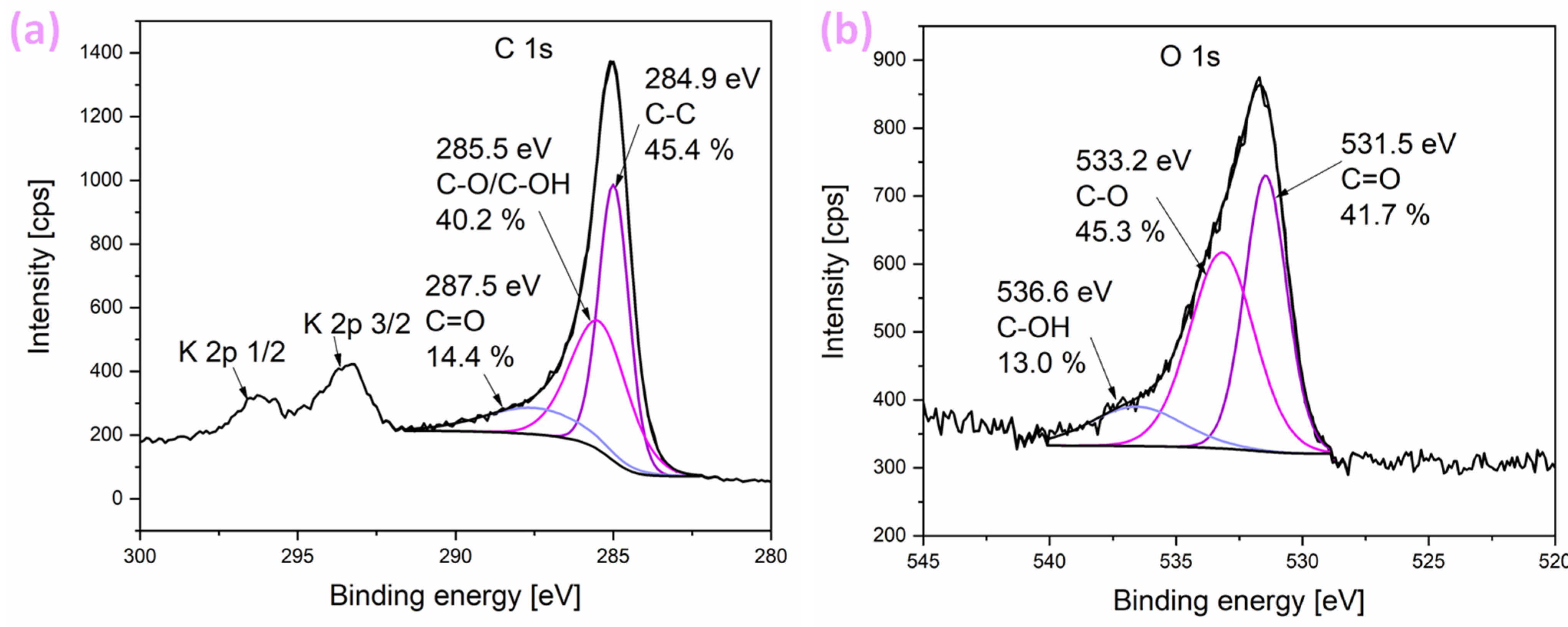
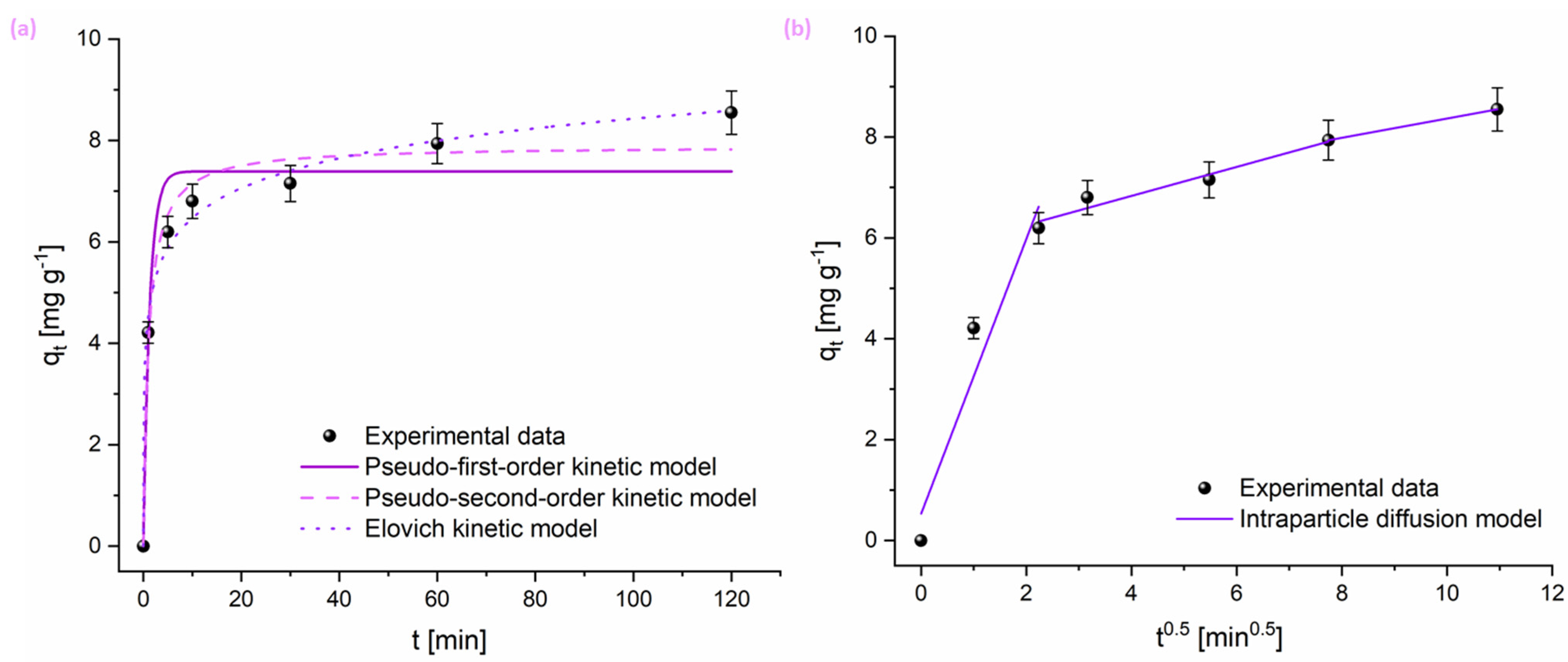
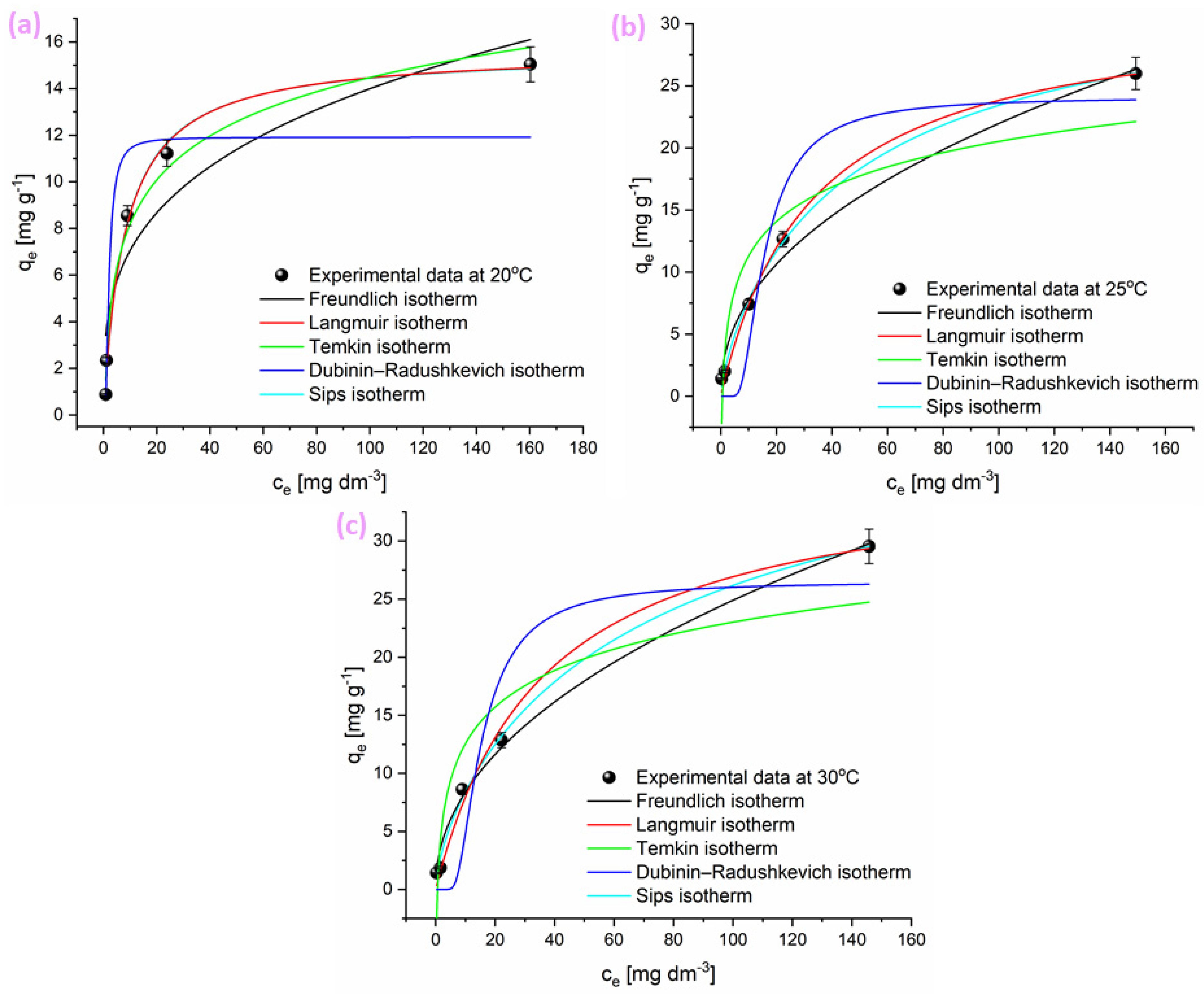
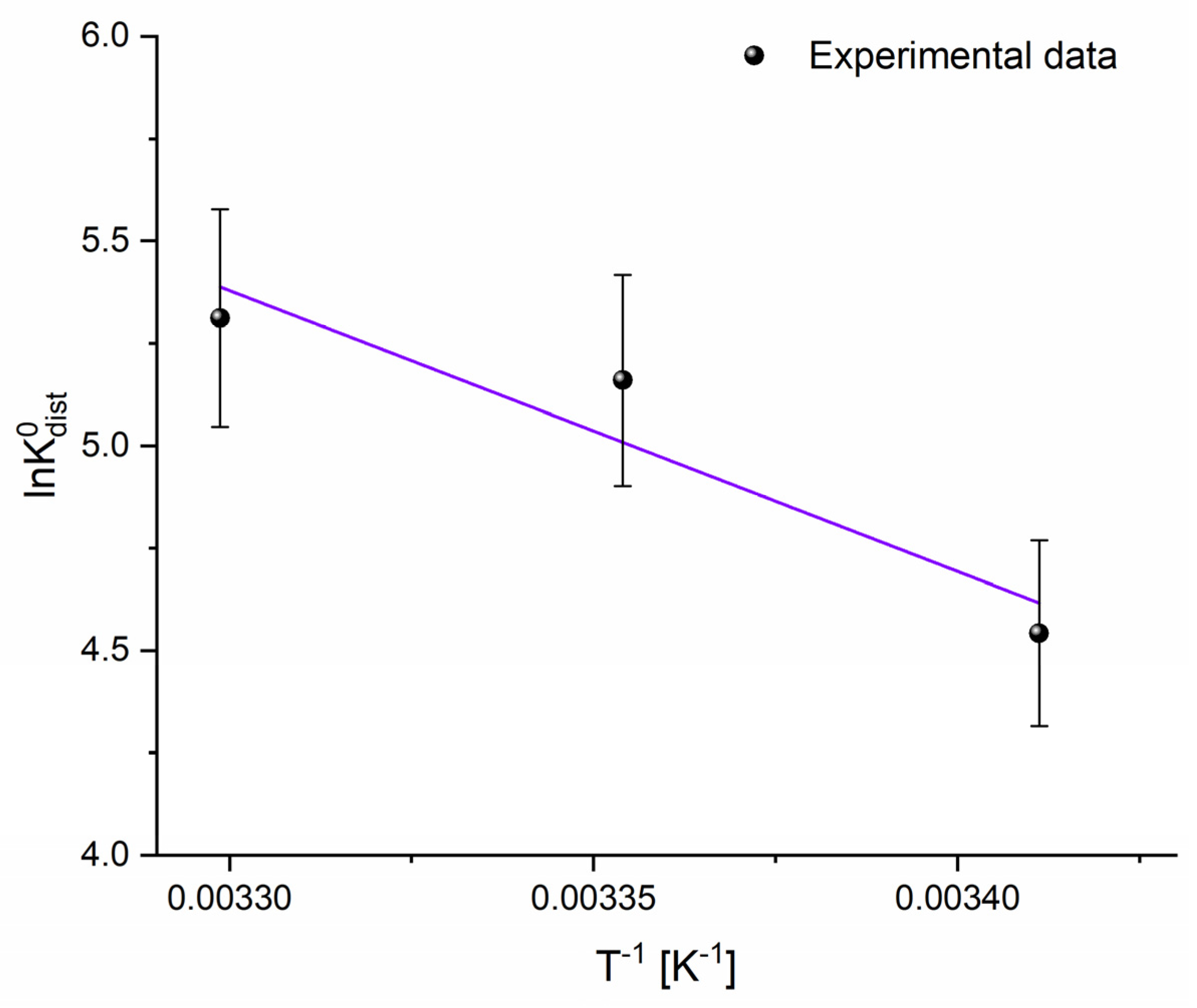

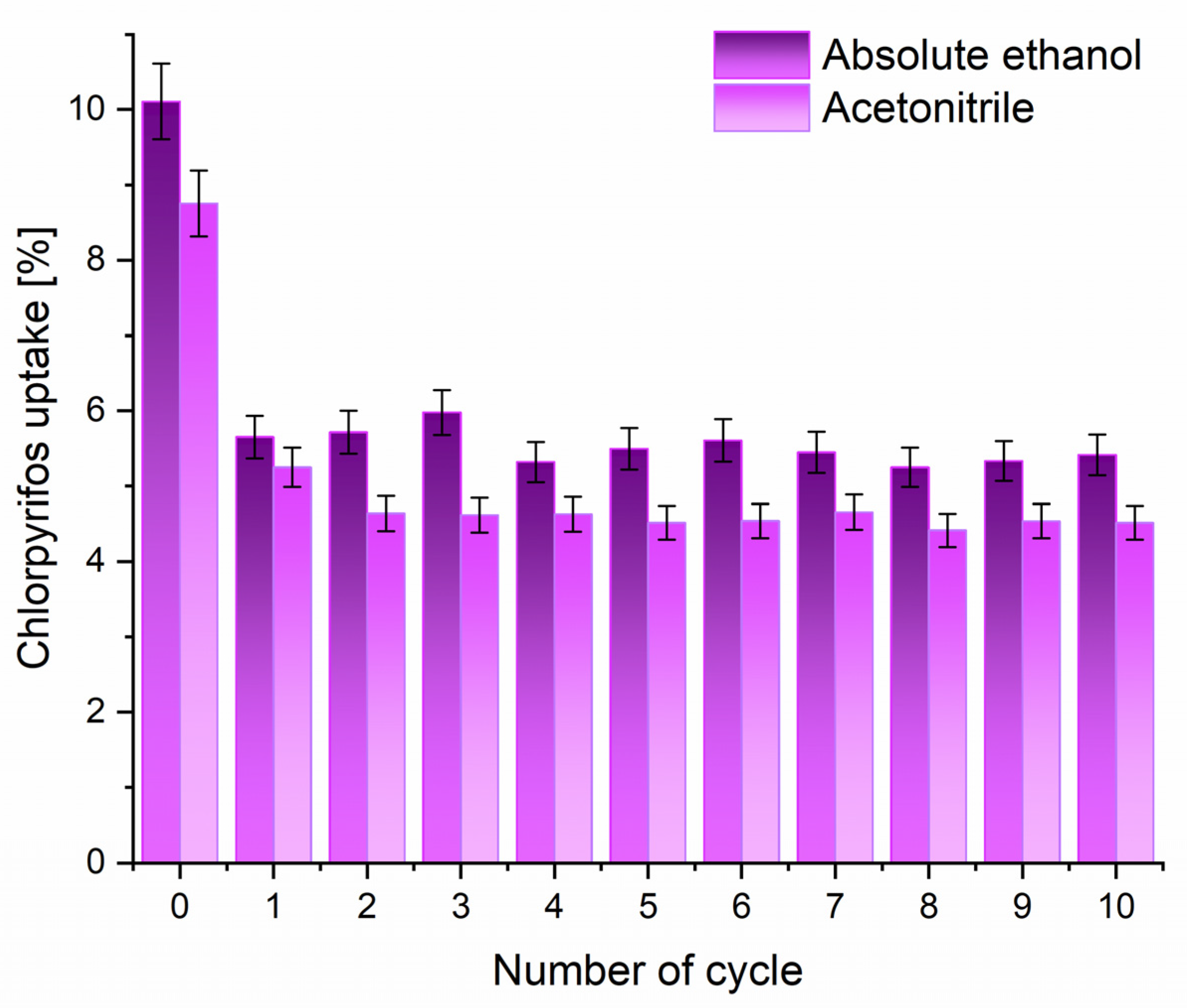
| Pseudo-first-order model | qe (mg g−1) | k1 (min−1) | χ2 | R2 |
| 7.39 ± 0.08 | 0.770 ± 0.007 | 0.636 | 0.926 | |
| Pseudo-second-order model | qe (mg g−1) | k2 (mg min−1 g−1) | χ2 | R2 |
| 7.89 ± 0.02 | 0.122 ± 0.004 | 0.227 | 0.973 | |
| Elovich kinetic model | α (mg g−1 min−1) | β (g mg−1) | χ2 | R2 |
| 170 ± 3 | 1.17 ± 0.01 | 0.074 | 0.991 | |
| Intraparticle diffusion model | I part | |||
| C (mg g−1) | kid (mg g−1 min−0.5) | R2 | ||
| 0.53 ± 0.04 | 2.7 ± 0.6 | 0.862 | ||
| II part | ||||
| C (mg g−1) | kid (mg g−1 min−0.5) | R2 | ||
| 5.68 ± 0.07 | 0.288 ± 0.009 | 0.931 | ||
| III part | ||||
| C (mg g−1) | kid (mg g−1 min−0.5) | R2 | ||
| 6.459 | 0.191 | - | ||
| T (°C) → | 20 | 25 | 30 |
| Freundlich isotherm | |||
| n | 3.4 ± 0.6 | 2.22 ± 0.02 | 2.11 ± 0.01 |
| KF ((dm3 mg−1)1/n) | 3.6 ± 0.5 | 2.75 ± 0.02 | 2.82 ± 0.02 |
| χ2 | 5.596 | 1.422 | 1.286 |
| R2 | 0.843 | 0.986 | 0.990 |
| Langmuir isotherm | |||
| qmax (mg g−1) | 15.6 ± 0.1 | 31.7 ± 0.1 | 36.6 ± 0.2 |
| KL (dm3 mg−1) | 0.123 ± 0.001 | 0.030 ± 0.002 | 0.028 ± 0.001 |
| χ2 | 0.295 | 0.520 | 1.436 |
| R2 | 0.992 | 0.995 | 0.989 |
| Temkin isotherm | |||
| KT (dm3 mg−1) | 2.00 ± 0.03 | 1.7 ± 0.6 | 1.6 ± 0.8 |
| bT (J g mol−1 mg−1) | 907 ± 5 | 620 ± 80 | 550 ± 50 |
| χ2 | 0.606 | 16.537 | 23.787 |
| R2 | 0.983 | 0.838 | 0.820 |
| Dubinin–Raduskevich isotherm | |||
| qDR (mg g−1) | 12 ± 2 | 24 ± 1 | 27 ± 8 |
| KDR (mol2 J−2) | (7.7 ± 0.7) × 10−7 | (3.2 ± 0.2) ×10−5 | (3.0 ± 0.5) × 10−5 |
| E (J mol−1) | 800 ± 70 | 120 ± 30 | 130 ± 90 |
| χ2 | 5.963 | 11.971 | 25.452 |
| R2 | 0.832 | 0.883 | 0.807 |
| Sips isotherm | |||
| Ks (dm3 mg−1)bs | 0.131 ± 0.002 | 0.014 ± 0.001 | 0.009 ± 0.001 |
| bs | 1.04 ± 0.03 | 0.719 ± 0.001 | 0.644 ± 0.002 |
| qmax (mg g−1) | 15.6 ± 0.2 | 34.3 ± 0.1 | 43.2 ± 0.2 |
| χ2 | 0.439 | 0.319 | 0.841 |
| R2 | 0.988 | 0.997 | 0.994 |
| Parameters | T (°C) | ||
| 20 | 25 | 30 | |
| ΔH0 (kJ mol−1) | 57 ± 1 | ||
| ΔS0 (J mol−1 K−1) | 230 ± 20 | ||
| ΔG0 (kJ mol−1) | −(11 ± 2) | −(12 ± 1) | −(14 ± 1) |
| R2 | 0.794 | ||
| Adsorbent | Adsorption Capacity, qe (mg g−1) | Equilibrium Isotherm Model | Temperature (°C) | Reference |
|---|---|---|---|---|
| Biochar samples derived from walnut shells | 3.536 | Langmuir isotherm | Room temperature | [41] |
| Cashew nut shell biochar | 31.34 | Langmuir isotherm | Room temperature | [42] |
| Untreated orange peels (UOPs) | 68 | Langmuir and Freundlich isotherm | 30 | [43] |
| Carbonaceous orange peels (COPs) | 108 | |||
| Nano magnetized orange peels (NMOPs) | 100 | |||
| Activated carbon derived from prickly pear seed waste | 35 | Freundlich isotherm | Room temperature | [44] |
| Bagasse biochar | 3.2 | Freundlich isotherm | 25 | [45] |
| Lemon peel | 6.37 | Freundlich isotherm | Room temperature | [46] |
| Cellulose-based carbon fibre | 132.0 | Sips | 25 | [47] |
| Activated-spent coffee grounds | 19.4 | Langmuir isotherm | 25 | [48] |
| Activated Mucuna pruriens seed shells | 8.8 | Temkin | 30 | [49] |
| Biowaste-derived magnetic hydrochar | 124.5 | Langmuir isotherm | 30 | [50] |
| Giant reed-derived deashed biochar | 21.8 | Langmuir isotherm | [51] | |
| Nanocellulose | 12.325 | Langmuir isotherm | 15 | [52] |
| 9.654 | 25 | |||
| 7.247 | 35 | |||
| 7.237 | Sips isotherm | 15 | ||
| 5.946 | 25 | |||
| 5.017 | 35 | |||
| Sunflower seed shells | 33.5 | Langmuir and Freundlich isotherm | 25 | [53] |
| Rice husk | 13.6 | |||
| Young walnut | 15.6 ± 0.1 | Langmuir isotherm | 20 | This study |
| 31.7 ± 0.1 | 25 | |||
| 36.6 ± 0.2 | 30 | |||
| 15.6 ± 0.2 | Sips isotherm | 20 | ||
| 34.3 ± 0.1 | 25 | |||
| 43.2 ± 0.2 | 30 |
Disclaimer/Publisher’s Note: The statements, opinions and data contained in all publications are solely those of the individual author(s) and contributor(s) and not of MDPI and/or the editor(s). MDPI and/or the editor(s) disclaim responsibility for any injury to people or property resulting from any ideas, methods, instructions or products referred to in the content. |
© 2025 by the authors. Licensee MDPI, Basel, Switzerland. This article is an open access article distributed under the terms and conditions of the Creative Commons Attribution (CC BY) license (https://creativecommons.org/licenses/by/4.0/).
Share and Cite
Kurtić, R.; Tasić, T.; Milanković, V.; Anićijević, V.J.; Rakočević, L.; Potkonjak, N.; Unterweger, C.; Pašti, I.A.; Lazarević-Pašti, T. Selective Removal of Chlorpyrifos from Contaminated Water Using Young Walnut-Derived Carbon Material as a Sustainable Adsorbent. Processes 2025, 13, 3357. https://doi.org/10.3390/pr13103357
Kurtić R, Tasić T, Milanković V, Anićijević VJ, Rakočević L, Potkonjak N, Unterweger C, Pašti IA, Lazarević-Pašti T. Selective Removal of Chlorpyrifos from Contaminated Water Using Young Walnut-Derived Carbon Material as a Sustainable Adsorbent. Processes. 2025; 13(10):3357. https://doi.org/10.3390/pr13103357
Chicago/Turabian StyleKurtić, Rialda, Tamara Tasić, Vedran Milanković, Vladan J. Anićijević, Lazar Rakočević, Nebojša Potkonjak, Christoph Unterweger, Igor A. Pašti, and Tamara Lazarević-Pašti. 2025. "Selective Removal of Chlorpyrifos from Contaminated Water Using Young Walnut-Derived Carbon Material as a Sustainable Adsorbent" Processes 13, no. 10: 3357. https://doi.org/10.3390/pr13103357
APA StyleKurtić, R., Tasić, T., Milanković, V., Anićijević, V. J., Rakočević, L., Potkonjak, N., Unterweger, C., Pašti, I. A., & Lazarević-Pašti, T. (2025). Selective Removal of Chlorpyrifos from Contaminated Water Using Young Walnut-Derived Carbon Material as a Sustainable Adsorbent. Processes, 13(10), 3357. https://doi.org/10.3390/pr13103357













